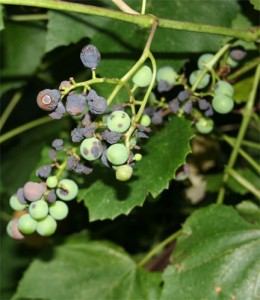Pruning of grapevines will be in full swing soon and dropping fruit mummies to the ground can greatly aid in controlling black rot. Black rot is a potentially devastating fungal disease infecting leaves, shoots, berries and cluster stems. Susceptibility to black rot varies greatly by variety but can be a concern for many American, French Hybrid or vinifera varieties. Black rot is the bane of organic grape growers due to the limited materials available for its control and the extreme crop losses from berry infections. In warm, humid climates like those of the eastern United States, the entire harvest may be lost to black rot.

The importance of sanitation in preventing black rot infections cannot be over– emphasized. Sanitation plays a huge role in limiting the amount of black rot inoculum found in a vineyard. The largest reservoir of inoculum is typically found in fruit mummies. Those retained in the canopy, attached to old cluster stems, provide inoculum much later into the growing season than those that have fallen to the vineyard floor. If mummies cannot be removed from the vineyard, the next best option is to make sure that all mummies are dropped to the vineyard floor to reduce the length of time spores will be available in the coming year. Once on the ground, mummies can be covered with a dirt berm or cultivation, effectively limiting the number of spores released to the air to settle on susceptible leaves, shoots and berries. In a small planting, removal of infected fruit as it is discovered during the growing season is another way to limit the amount of inoculum. Pruning out infected canes and removing them from the vineyard reduces the level of overwintering inoculum. Sanitation is an essential component of black rot IPM. For more information on black rot, a downloadable PDF — a Grape IPM Disease Identification Fact Sheet — can be found on the NYS IPM website.
Author: Timothy Weigle, Grape IPM Educator
Photo courtesy Timothy Weigle